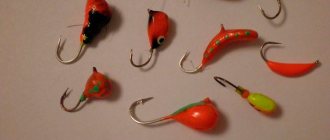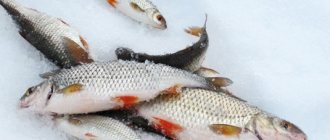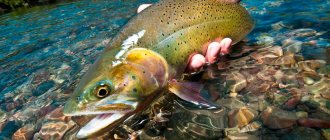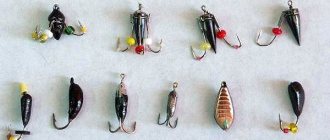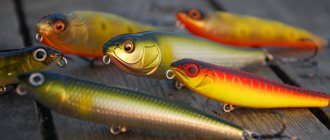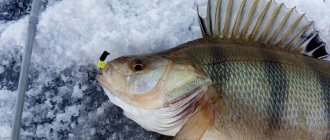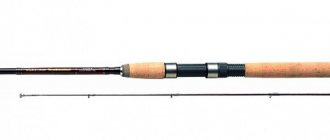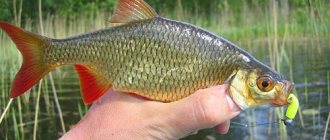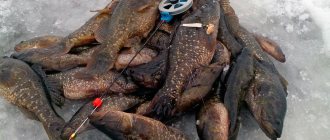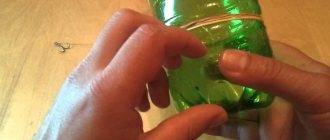If you have never tried ice fishing, but intend to master this type of fishing, our article today is guaranteed to give you a lot of necessary information. The fact is that jig fishing is the easiest to learn, most common and budget type of winter fishing. At first, special financial costs are not necessary, and neither is filigree possession of tackle. In short, this option is available to anyone and everyone who is interested in mastering this exciting hobby.
In this publication we will examine the main aspects of using this versatile piece of equipment. We will learn how to assemble gear for various types of fishing, select and combine baits, choose the optimal fishing line and much more. It is quite difficult to cover all the nuances of jig fishing in one article, but it is quite possible to identify a starting point for a novice fisherman. Next up is reading topical articles, watching videos and a lot of practice!
The essence of jig fishing
A jig in the classical sense of the word is an artificial bait that imitates a miniature amphipod crustacean. This crustacean (along with bloodworms) is the basis of the food supply for all peaceful and some predatory fish in the winter. True, modern baits of this class have significantly moved away from living prototypes, acquiring very intricate shapes and colors. However, the essence and basis of the design remained the same: a metal “body” that plays the role of a spinner and a weight, and a hook (or several) implanted into it.
This bait provides a rich catch even with a bad bite! More details Initially, jigs were intended exclusively for bait fishing: they were necessarily used in tandem with edible baits. Fishing was carried out mainly stationary: the fishing rod was installed above the hole, at which point the fisherman’s actions ended. Later, fly fishing appeared: during it, the angler does not let go of the fishing rod, manipulating it and playing with the bait. This serves to additionally attract fish - it responds to both movement and acoustic signals.
Winter fishing with wire has become so popular that it has initiated the emergence of a new class of baits – reelless baits. These are jigs that work solely due to the game - the presence of edible bait is not expected at all.
In addition, such baits are also used for alternative types of fishing. For example, to catch white fish in strong currents using bottom gear (“helicopters”, “droppers”), baits of this class are used on diverting leashes. In this case, a large weight is hung on the main line, fixing the equipment relative to the bottom, and several light jigs are mounted on the outlet leash. There are other options for equipment.
By the way, they can successfully catch fish with jigs in the summer, mostly vertically from a boat or a steep bank. In a word, we have before us a truly universal bait, you just need to learn how to choose it rationally and use it wisely when fishing.
Where to look for crucian carp in winter?
A reasonable question if you are planning to go winter fishing. Where can you catch it? Where to go? For each body of water, searching for crucian carp is carried out differently.
Like other types of fish, with the arrival of cold weather, crucian carp goes to deeper areas, because the water temperature there is constant. But! Crucian carp is found at shallower depths than other fish.
The main reason for this behavior is the food supply. Crucian carp can be found on flat areas of the bottom, because sometimes bloodworms are caught there. But schools of this type of fish prefer pits. And crucian carp also likes to be in thickets of reeds and cattails, i.e. at very shallow depths.
To summarize, I would like to note that:
- The fishing location is low-flow ponds and lakes that have a muddy bottom.
- Fishing depth is from 1 to 3 meters. It will be quite difficult to catch crucian carp deeper.
It is important to note that under good circumstances and with the right fishing location, a good catch will be constant. When searching for a fishing spot, you can also be guided by information acquired during summer fishing.
Types of jigs
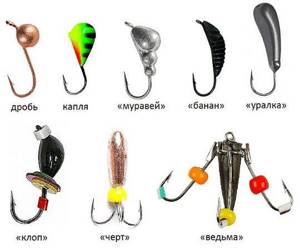
The first jigs were exclusively handicraft. To make them, fishermen used mainly lead or its alloy with tin - you can’t handle hard metals at home. Now the industry is rushing to keep up with the needs of anglers, but many fans continue to make or at least modify their own baits.
As mentioned above, all jigs can be divided into two broad classes: for use with and without bait. Mothless fish are usually brighter, more visually appealing and more intricate in shape, because they present a single whole in the eyes of the fish, tempting and potentially edible.
Most baited jigs are simple droplets, cones or balls, the main task of which is to deliver edible bait to the bottom and hold it at a selected point.
Materials
Most jigs are still made of metal. In baitless fishing, jigs made of lead and tin are actively used, but the arsenal of a modern winter fisherman should also include tungsten baits. They cost an order of magnitude more, but when fishing downstream or at significant depths, it is problematic to do without tungsten frames. The fact is that tungsten is almost three times heavier than lead, and such a jig with a modest volume has a significant mass.
Lures made from solid rod rather than powdered metal are considered to be of the highest quality. The vast majority of factory socketless guns are made from steel and alloys, but there are tungsten and lead options. Experienced fishermen sometimes make real works of art from ordinary lead plates - it is impossible to work with tungsten at home.
Plastic “fireflies” can be included in a separate category. They are light in weight and usually play an auxiliary function when fishing at great depths and in the dark.
Color
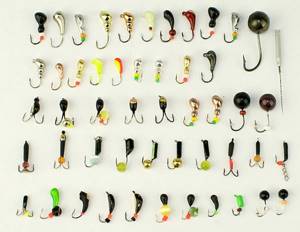
Contrary to popular belief, the color of the bait does not greatly affect the fishing performance. The basis of a jig fisherman's arsenal is made up of lures of classic colors: silver, golden, black. By the way, white fish go well with black jigs during the deep winter (if they go for anything at all).
However, bait manufacturers compete with each other in their level of imagination when it comes to coloring jigs, especially for baitless fishing. The predominant colors are yellow, orange, and green with longitudinal or transverse stripes. And all sorts of bright “decorations” are hung on the hooks of reelless hooks to indicate the point of attack: beads, pieces of cambric, colored threads, and so on. Perch is especially partial to bright colors.
In poor visibility conditions, options coated with fluorescent compounds perform well. They work especially effectively on pike perch, but other predators, and sometimes peaceful fish, do not remain indifferent to such illumination.
Size, weight and configuration
The mass of most moths ranges from 0.1 to 0.3 grams, the diameter is about 2-4 mm. Reelless fish are many times larger and heavier, because they are perceived by the fish as a single whole - potential prey.
The configuration of winter jigs for bait fishing is usually simpler, because their function is mainly to weigh down the natural bait (usually bloodworms) and hold it at the desired point . They have the shape of a ball, pellet, pear, drop with an appropriate size hook.
The design of the mothless fish is much more intricate, because the shape and color are designed to provide an attractive game from the point of view of potential prey. Let's look at the most common options:
- Sausage . A cut rod of metal with a square or round cross-section.
- Dreissen . Heavy bait with a nodding action, effective for white fish.
- Owl . Essentially, this is a flattened micro-spoon aimed at zander and perch.
- Ants, bugs, nymphs . Lures of an elongated shape with a characteristic bend, sometimes segmented, are the most popular and universal option.
- Goat . Active fish of all types are caught with this type of jig. A characteristic feature is two hooks, rigidly fixed at an angle to each other.
- Uralka . A very popular bait, shaped like a curved eggplant.
- Cobra . A flat-concave bait with one hook, designed for gliding animation.
- Cuttlefish . Shaped like the aforementioned cobra, but has two hooks like a goat.
- Devil . A very popular universal bait with a lot of modifications. The body is oblong, of varying degrees of “elongation”; the equipment is usually three hooks soldered into the body of the bait or a freely suspended tee.
- Carnations . The simplest baits are elongated in shape, essentially a solder on a hook and equipped with large accessories in the form of cubes or bright beads. The notorious “cat's eye” is from the same opera.
- Balda, witch and other heavy mothless creatures . In principle, these are no longer exactly jigs, but rather spinners aimed at catching predators from the bottom. The basic principle of fishing is tapping on the bottom surface, which provides strong acoustic signals.
To catch large predators in the current, super-heavy jigs weighing up to 100 grams are often used with bait made from a worm, a piece of fish, sprat, and so on. This is a separate class of baits that requires special handling and acquired skill.
How to choose the right fishing rod
As already mentioned, a special spinning rod must be chosen. The product should be such that you can not only cast the bait as far as possible, but also be able to easily play with it. Experienced fishermen advise paying attention to the ultralight system, which has a test value of 0.5 grams.
Important! The rod should be sensitive, comfortable, soft, but at the same time strong.
Only with such a detail a good catch will not be long in coming.
There are a great many models that have the characteristics described above. However, despite this, choosing something suitable can be very difficult. The reason lies precisely in the abundance of different names, which are insignificantly disconnected from each other, but still. Most professionals advise taking a closer look at a trout rod. These include products labeled SXUL, XUL, XXUL, SUL, which have a low test value. Thanks to such products, you can fish with baits weighing less than 0.5 grams.
Slow and parabolic action is what the above-described fishing rods can boast of. This feature allows you to cast jigs as far as possible with extreme ease, and also play with the bait without any difficulty. Due to the softness of the tackle, you can be sure that not a single fish will fall off the hook.
As for the shortcomings, there are some. Among these we can note inaccuracy during casting. However, with practice, this will not be a problem, because the fisherman will get used to throwing the jig where he needs it.
Today there are several models for nanojig, which are in great demand.
This:
- Abu Garcia Diplomat Boron,
- Major Craft Trapara,
- Tenryu Areas,
- Smith Fieldream,
- Graphiteleader Bellezza,
- Major Craft Nextino.
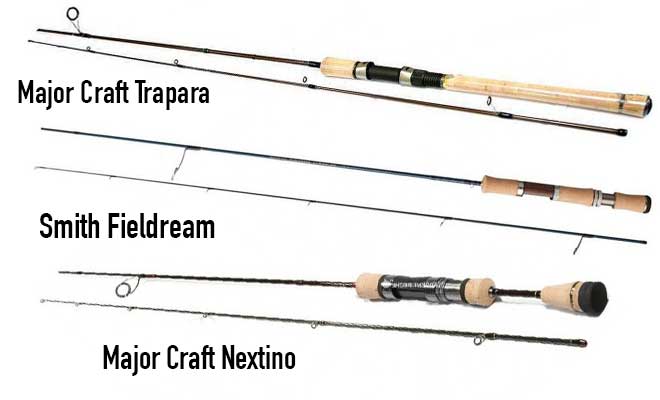
It must be said that there are many more elements on sale and they are all of high quality and reliable.
Gear device
The design of winter tackle for jig fishing cannot be called complicated: a short winter fishing rod, a fishing line, an alarm and the bait itself. It would seem nothing complicated, but combining these elements into an effectively working system is not so simple: they must be optimally matched to each other. Moreover, the leading element in this case is the bait: its weight, configuration, presence/absence of bait determines the characteristics of other components of the equipment.
In the cold, selecting elements is quite problematic, and you don’t want to waste time on it, so experienced winter skiers take several fishing rods with different jigs for fishing at once, and determine on the spot which one is best suited to the current conditions.
For a beginner, two or three equipped gears are enough. They are not too expensive (remember, we are talking about amateur fishing), so you can afford them from the start.
Fishing rod
The main and most expensive element of the equipment is the fishing rod, although the price of the issue is also low - about 300 rubles maximum. The length of the fishing rod is a maximum of 30 cm, the weight is less, the better (from 15 to 120 grams). Lightness is especially important when fishing for the game - stationary fishing can also be done with heavier gear.
The most common type of fishing rod is the “balalaika”, which is convenient in all respects (the reel with a closed body is also a handle). Axle-free options with a reel-handle, which is a ring, are also good. If you are going to fish with a jig in a stationary way or catch a large predator for the game, you can also use heavier fishing rods with reels distanced from the handle (the so-called winter spinning rods).
By the way, some fishermen, for the sake of lightness of gear, refuse reels altogether. In this case, a structure for winding up the fishing line (hooks or notches) is provided on the cork or foam handle. However, you need to understand that it will not be possible to protect an open fishing line from freezing, and this automatically leads to a loss of sensitivity and an increase in the weight of the gear.
fishing line
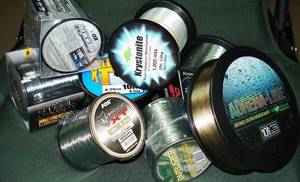
The main criteria in this case are maximum load capacity with a minimum diameter, as well as stealth in water. The thinnest equipment should be used in the dead of winter, when the fish are inactive.
The most commonly used is special winter monofilament or fluorocarbon. Fluorocarbon is usually more expensive, but when fishing with a jig, line consumption is minimal, so you can afford such a “luxury”.
In mormyshing, fishing line with a diameter of 0.05-0.12 mm . However, the thinnest thread is used mainly by athletes, and is rarely used in amateur fishing. It is recommended to equip three tackles with fishing line of different diameters: 0.07-0.08 mm, 0.1 mm and 0.12 mm. The second option is considered the most universal and suitable for a wide range of conditions. The first option is optimal for fishing at significant depths and in the dead of winter, the second - for shallow depths and fairly heavy baits.
Alarm
In most cases, the role of a signaling device is played by a nod (guard). This element was previously made from boar bristles, now mainly from lavsan or metal tape. Mylar nods are considered more sensitive, which ensures the most realistic game and quick reactions, but in strong winds it is difficult to distinguish a bite.
The length of the guard is selected depending on the type of animation: the longer the nod, the softer and lazier the game. For example, for bream you will need a longer guard, for a fan of the sharp game of perch - a shorter one. Choosing a nod for a reelless bait is even more difficult: most of the points are learned from personal experience, because each bait of this type behaves differently in the hands of different anglers.
It is considered that the guard is adjusted correctly if, under the weight of the bait, it bends at an angle of about 45°C. But this, again, is not an axiom: the main indicator of the correct setting of the nod is effectiveness, and this can only be understood through experience. Moreover: in baitless fishing, the most sensitive gear without a reel or nod is often used, because sometimes the animation is set even by tapping a finger on a miniature handle made of foam or cork.
Stationary fishing with a jig can also be float-based even in winter and ice conditions, and the alarm is adjusted to float. As in all other cases, the carrying capacity of the float is adjusted to the weight of the bait.
Tackle for jig fishing
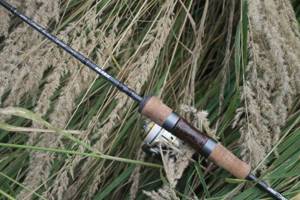
Spinning rods for fishing with jigs are used with the minimum possible test, most often these are “twigs” with an upper limit of up to 5 grams, or better yet, even less. The action is medium or medium-fast, the glued tip of the “solid” type will be a big plus for better wiring of light jigs. Usually the length of such spinning rods does not exceed two meters, which is more than enough. Coils are used in small sizes: from 500 to 1000, rarely more. Such delicate spinning rods require the minimum possible weight of the reel for good balance and practicality in fishing. Thus facilitating all stages of fishing: casting, retrieving, bait control and bite registration. Classic jig fishing is fishing with monofilament of thin diameters, usually 0.06 - 0.08 mm. But with the development of technology, it becomes possible to fish with jigs and with the thinnest cords and nanofilament. Choosing a specific basis for fishing is a purely individual matter, because both have their pros and cons.
Tying a jig
There are two types of nozzle jigs: with a hole in the middle and a special eyelet for fishing line. Cambrics are usually inserted into the holes in the body of tungsten lures so that the very hard metal does not fray the fishing line.
The easiest way to tie a jig to a hole is with a regular self-tightening loop. It is knitted extremely simply:
- We thread the tip of the fishing line into the hole.
- We form a loop near the shank and press it to the hook.
- We make several turns of the fishing line around the fore-end.
- We thread the tip into the loop.
- We wet the fishing line, tighten the knot, and cut off the tail. A knot is formed on the hook!
If the bait has a special eye, you can use the previous option by passing the fishing line through the ring. In this case, the bait will be positioned at an angle, which is certainly good for fishing with a reelless bait: in this case, the hook should not be directed straight down, but at an angle to get into the fish’s mouth when attacking.
If you are fishing with a classic jig, it is impossible to predict the catchability in advance: sometimes the fish like this angle, and sometimes it is better to attach the bait with a natural vertical plumb. This can be done with the simplest palomar:
- We form a loop from the fishing line and thread it through the eye of the bait.
- We tie the loop into a regular knot with the main fishing line.
- We pass the hook and all the bait through the loop.
- We form a knot, wet the fishing line, tighten it, and trim the ends.
Sometimes more complex rigs of several baits are used (on the main line or a lead), but at first it is better to get by with one jig and focus your efforts on learning how to handle it correctly.
In the arsenal of every fisherman there are many times tested knots, which he considers the most reliable. Therefore, we have presented here only two of the simplest options available even to a green beginner.
DIY jigs
Often fishermen do not use industrial production, but jigs that are made with their own hands. The device is quite simple to make from lead. To do this, select a mold of the desired size, pour in molten lead and insert the hook into it with the ring facing outward. After the metal hardens, it is coated: turned, painted and polished. You can connect a “pellet” jig with a hook with your own hands. The forend is placed in the sinker section, with the ring remaining outside, and clamped with pliers. When making gear at home, a soldering iron is useful. A “droplet” of the required weight and size is soldered onto the hook.
We recommend that you read additionally:
Fishing with a jig is a very exciting and productive activity. Crucian carp responds well to the play of this device in the water, and you can boast of an excellent catch in any season of the year. A common misconception is that fish bite on this device only in winter. Of course, winter fishing is most popular, but its effectiveness at other times of the year has been proven by experienced fishermen. There is a wide variety of jigs and when choosing, you should focus on the following factors: time of year, habitat of crucian carp, food preferences.
Check out a very useful video about crucian carp killer gear.
Selection and preparation of a site
The choice of place for winter fishing is determined both by the chosen tactics and by the characteristics of the seasonal behavior of the fish. If we take general principles, then in terms of first ice the most promising areas are along coastal thickets, edges and slopes, near islands of vegetation, snags, and so on. In the dead of winter, fish move to greater depths and practically do not move, and closer to the ice drift they begin to be active throughout the entire reservoir (especially for predators).
When fishing with a stationary jig, choosing a promising location is especially important, but in winter it is understandably difficult. In this case, knowledge of the topography of the reservoir obtained in the summer or the presence of an echo sounder will be very helpful. In this case, you need to determine a promising place, drill several holes and feed. Preference should be given to formulations with the addition of animal components that are distributed in the water column, and at significant depths, use special winter feeders.
Fans of game fishing on the first or last ice often use the active search method: they saw a visually attractive place, drilled holes, fished, moved on, and repeated the manipulations. In the wilderness, it is better to abandon such tactics: careful selection of locations, bait, experiments with baits and animation techniques come first.
Rod
Since the bait is super small, the rod should be ultra-light and clear. When fishing with a jig, the tackle must be selected very carefully in order to be able to convey the game with such a sensitive bait, and to find your rod. It will be impossible to control the game with your hand; the small weight of the bait will not be felt.
The rod is, of course, ultralight. The tip should be glued, thin and sensitive, because the baits are light. The structure is parabolic, not rigid. Length around 2.10 meters.
With such characteristics, the cast will be far. A shorter rod length will affect the casting distance.
The wind, even a slight one, will hinder a good cast. The bait is light, the wind will create windage on the cord, and contact with the bait will not work. It is best to fish with such gear on small rivers. Less open space will attract less wind.
Stationary fishing with a jig with a nozzle

Bait fishing involves the use of bait: in the vast majority of cases bloodworms (one, several or a bunch), but in some cases they use a worm, maggots, beetle larvae, natural amphipods, and so on. Using super-heavy jigs, pieces of fish, sprat or even live bait are hooked onto the predator.
The simplest option, optimally suitable for a beginner, is stationary fishing “on a riser”: there is no need to animate the bait, cut holes, place fishing rods and watch the float or nod. The most acute moment is the precise adjustment of the alarm to the rise and the quick response to a bite. However, it must be taken into account that here too there are a lot of nuances that can only be understood through experience, and besides, fishing for the game is a priori more effective, especially in the dead of winter.
The fact is that in winter the fish are less active and more cautious, so the same half-asleep bream or crucian carp can immediately spit out the bait when it feels a hook in its mouth. And it’s problematic to react instantly: usually an angler serves several holes with gear.
The advantage of jigs in spinning
Many fishermen have experimentally proven that it is precisely with bait weights of less than 1 gram that the number of bites and fish caught increases significantly. The miniature and ultra-light bait reminds the fish of its natural food and takes the bait without any fear. The formula is simple: “the less the weight of the bait, the greater the number of fish bites” always works flawlessly. That is why advanced fans of spinning and jig fishing most often use bait weights of 0.5 grams or less.
The amazing catchability of jigs is used by fishermen and sportsmen who practice the discipline of “spinning rod fishing from the shore.” At many competitions of this format, where the object of fishing is not trout, but perch, the vast majority of participants fish with a spinning rod using a jig.

Mormyshing significantly increases the species composition of spinning trophies. Completely non-predatory fish, such as dace, roach, crucian carp, bream, etc., become not a pleasant bycatch, but an object of targeted fishing. Very often it is the opportunity to catch peaceful white fish on a spinning rod that attracts new fans.
Mormyshing is an excellent option for those who do not have the opportunity to travel to long-distance fishing trips to Eldorado, but devote an hour or two to their favorite hobby on the nearest pond or river. It is in such reservoirs, where it seems that there are no fish, that thanks to jig fishing, the angler has the opportunity to feel the joy of biting, playing and catching fish.
It is practiced by “aesthetes” from ultralight fishing, who are keen on fishing for the thrill. Fishing for an ordinary perch weighing 150 grams on super-thin gear feels comparable to catching a “kilosh” pike.
Fans of jig fishing are often reproached for catching only small fish. But such a reproach is absolutely unfounded. Humpback perch bite on jigs no worse (if not better) than on other jig baits. It’s just that very often adepts of the spinning jig manage to catch something where others don’t see a bite. And that “something” is often small perch.
Mormyshing for the game
Active mormyshing is much more difficult. The use of a reelless reel will require the greatest skill from the fisherman, because in this case the lion's share of success depends on the skill of the fisherman. There is no such thing as the most catchy jig: all the ratings, supposedly compiled by winter fishing professionals, do not stand up to criticism in this case. In this case, what is important is individual skill, careful preparation of gear and the ability to adapt to the current conditions of the reservoir - everything else is secondary.
Let's look at the basic principles of winter fishing with jig animation step by step. This is too broad a topic, so we will focus on general information that is most relevant for a beginner - the nuances can be learned in practice during the first trips to the ice.
What kind of fish can be caught with a jig?
The most likely catch is a perch up to 100 g in size. It bites on a cut made of edible rubber and attached to a hook. There are also roaches of the same size. But large fish also often bite.
Among the large specimens you can find rudd, bream and crucian carp. Carp are less common. In many reservoirs of the country, ide, bleak, and dace are caught using nanojigging. You can catch ruffe, pike perch and pike using jigs for jigs as by-catch.
Rules for handling tackle

There are few universal rules for handling a fishing rod, since every experienced fisherman has his own style, which has been practiced over the years. However, there are some starting positions that a beginner needs to take into account.
Right-handed people usually hold the fishing rod with only one, right hand, manipulating it or tapping the tackle with their fingers. But sometimes they help themselves with their left hand, placing the whip between her thumb and forefinger. In this case, during active fishing, the right hand will set the amplitude of the movements of the jig, and the left hand will set their frequency. We remind you that the tackle is very delicate, sensitive even to micro-movements, requiring delicate handling. Parasitic movements of one's own limbs to the sides should be eliminated as much as possible: the bait should move vertically or at a slight angle to it (if we are talking about bait fishing).
It is necessary to take into account that you will have to perform small monotonous movements, so you need to keep your hands as relaxed as possible. While fishing, it is recommended to rest your elbow on your thigh and periodically shift the tackle from hand to hand to avoid numbness in your limbs. You can support the hand with the fishing rod with your other hand, giving it additional support and relieving accumulated fatigue.
Effective forms
Crucian carp have a small mouth cavity, and this feature must be taken into account when choosing fishing equipment. The ideal jig size is 2-3 mm in diameter. It is these products of various shapes that will bring results when fishing for crucian carp. Let's look at the most popular models of jigs.
"Pellet"
“Drobinka” got its name due to the similarity of shapes - it is round and smooth. The most versatile jig, which is suitable for fishing at shallow depths - up to 2 meters. The “pellet” moves easily among aquatic vegetation, which attracts the attention of fish. When fishing with this jig, you can rely on raising the bottom silt and playing with crucian carp.
"Droplet"
The “droplet” has more weight compared to the “pellet”, therefore it is intended for deeper sea fishing. Used in different seasons of the year, both with and without bait.
"Ant"
The most popular baitless jig. It got its name for its resemblance to an ant or small larva. When dropped into water, it perfectly imitates the movement and behavior of an insect that accidentally finds itself in a body of water. To attract attention, it is equipped with bright accessories, such as beads or beads. Can also be used with bait.
"Uralochka"
It is equipped with various bright elements and is used for playing with crucian carp. In appearance it resembles an aquatic crustacean, which is the usual diet of crucian carp, and therefore attracts the attention of this fish. Can be used for fishing with or without bait.
"Banana"
Another bottom jig, which is used without bait. It is shaped like a banana. It is used for fishing in stagnant bodies of water, without much current. Popular for summer and winter crucian fishing.
"Bug"
Resembles an aquatic insect in appearance and imitates its movements. Mainly intended for winter fishing, but can also be used in summer when the bottom is clear.
The most efficient wiring
There are no universal wirings - this is an axiom. The choice of animation depends on many factors: the presence and strength of currents, wind conditions, characteristics of gear, time of year, behavioral characteristics of the intended prey, and so on. Catching fish with a jig with a nozzle is objectively easier: the bait moves primarily vertically, while with reelless baits, depending on the shape, you can set a more intricate trajectory.
You should master several basic postings and vary them as necessary:
- Step . Universal wiring for most jigs, quite easy to learn. The bait sinks to the bottom and then rises sequentially with a pause at each “step”. The rise of the fishing rod when overcoming each step can be 0.5-3 cm.
- Saw . In this case, the bait moves along a trajectory reminiscent of saw teeth: rises alternate with drops. Pauses are provided at both the top and bottom points.
- Shaking . The fishing rod makes shaking movements with its whip in a vertical plane. Wiring is good when catching passive fish using any jig in the bottom layer.
- Dribbling . Reminds me of shaking: the same high-frequency vertical movements of the bait. Dribbling is usually done by tapping the rod with your finger.
- Uniform rise . Retrieving is difficult to perform (only an experienced angler can evenly lift the jig from the bottom), but it works well against a trophy predator. You can alternate the rise with twitches through well-calibrated, even pauses.
- Pendulum . Wiring used primarily for rewindless machines with their own game. The pendulum is provided by the rotational or oscillatory movements of the whip.
- Tapping . Tapping can be carried out according to various schemes: once for several small rises with twitching at the top point, or after a sharp rise from the bottom to a height of up to 30 cm. As a result, a cloud of turbidity is formed and acoustic signals are created. With heavy jigs such as baldy, they are caught exclusively by tapping, and in this way they mainly catch large predators.
All of the above are just basic wiring that can and should be modified depending on conditions. You can speed up or slow down, change the frequency, amplitude and duration of pauses. By the way, the closer to the wilderness, the longer the pauses (up to half a minute).
Fishing and retrieving techniques in jig fishing
The advantage of jig fishing over other types of fishing is the wide variety of fishing lines used in fishing. In addition to standard types of fishing, fishermen invent their own combinations that bring fish even when they cannot be caught in other ways.
The main task is to achieve such an animation of the bait (using the tip of a spinning rod) that will attract the attention of the desired trophy. You need to determine in what place and at what height the fish is standing, and by changing the types of fishing, this can be done easily.
Experienced fishermen believe that the choice of fishing line is an individual decision for each body of water, but it also depends on:
- type of reservoir;
- types of supposed trophies;
- depth at the fishing point;
- fish activity;
- season when fishing takes place.
After all, it’s one thing to catch a roach in a pond and quite another thing if you catch a perch or the same trout in a stormy river. The growing popularity of jig fishing is precisely due to the fact that it is used in those reservoirs where there seem to be few fish, but with the help of a spinning rod and a light bait it is possible to catch them.
Fishermen do not always have time to go to a rich body of water far from home, so jig fishing in the reservoirs of the park area becomes an outlet. It’s not even a matter of the size and number of trophies, but the opportunity to do what you love again and again and get great pleasure from it.
Wiring during nanojig is conventionally divided into three types:
- pulling bait in the bottom layer;
- wiring in the water column at an average level;
- animation of the bait near the surface.
The fish standing in the bottom layer are larger, but a light bait should sink faster, and the angler will feel how close to the bottom it moves. Crucian carp can also be caught with jig fishing, although not as large as with a float or feeder.
What it’s like to bite even a 300-gram crucian carp on an ultra-light spinning rod is known only to real fans of jig fishing, who know how to perform effective retrieves near the bottom.
Bottom wiring is fraught with snags and loss of jigs, but this has to be treated as an inevitable fact. Jigs are still consumables and losing them while fishing is a common occurrence. That is why experienced fans of microjig always carry a large supply of jigs of different weights and colors with them to reservoirs.
When fishing from a boat, there is always a place for a box with bait, but when fishing in a wade, you need to use unloading vests or belts with pockets for storing jigs, baits and tools. A short landing net, attached to the hand with a cord, will also not hurt, making the process of landing fish easier.
In the middle layers of the water there are different fish, both white and predator, and it is difficult to predict which of them will bite first.
Selection is carried out using:
- choosing the shape and color of the jigs used;
- the wiring used;
- a bait placed on a hook, artificial or live.
Pulling the jig in the middle layers of water is done at a slow pace, animating the bait with the tip of the rod. The wiring is smooth with low amplitude and without sudden movements that scare away the fish.
With its energetic movements, the jig attracts perch or pike perch, rising from the bottom in search of a school of small fish. But the fisherman needs to be careful and immediately react to the bite, because a late hook will lead to the trophy disappearing.
The perch takes the bait greedily and at the same time seems to lose caution. In fact, the predator is very attentive and any careless movement of the bait will alert it and force it to refuse to bite.
Placing bait in the upper layer of water is somewhat reminiscent of fly fishing. The movement of the bait is smooth and measured, without sudden movements or impacts. This technique requires attention and experience, because the jig strives to sink to depth and in order to keep it on the surface you need to clearly act with the tip of the spinning rod.
At the top, peaceful fish bite better and to attract them they use semi-dry bait floating on the surface of the water.
Expert opinion
Vladimir Poltoranin
Fisherman - expert
The technique of moving a jig with a spinning rod also changes depending on the season:
In winter , after the onset of cold weather and freezing of reservoirs, spinning rods are not used, but are fished with jigs using winter fishing rods equipped with nods. In the spring, when the open water season begins, spinning rods are uncovered and jig fishing proves its advantages. At such times, fish stay in coastal areas, where the water is warmer and the food supply is more abundant. In spring, it is more promising to conduct in the upper and middle layers, at an average and slow pace, with virtually no sudden jerks. The bites are sluggish and at the slightest vibration of the whip a sharp hook is made. Jigs use shiny or bright colors with animal baits - bloodworms and maggots. the summer , there is freedom for the fish in warm water and there is plenty of food for them in the reservoir. In such conditions, it is more difficult to get both predators and peaceful fish to bite on the jig, so it is especially important to vary the technique of posting and experiment, showing aggressiveness. Fishing at long distances is more effective, as is fishing in the lower layers of water, where trophies are kept. In the morning hours, they fish from a boat areas near the reeds at shallow depths. As the sun rises, anglers go to greater depths, using energetic movements with the tip of the spinning rod when fishing. Highly attractive artificial baits and jigs in calm shades help diversify your fishing and achieve results. The weight of the jigs is selected so that they can be thrown long distance. Fishing at dawn and sunset is more successful and brings a plentiful catch. In autumn , during this period of the year, it is especially important to carefully study the reservoir and search for future wintering pits. Despite the fact that the fish is still moving in search of protein food, it involuntarily stays closer to its future wintering areas. In summer and autumn, fishing from a boat with short spinning rods is more effective. Light jigs, artificial baits in white and yellow. Autumn jig fishing is especially rich in trophy fish, and when fishing, you should not make sudden movements with a spinning rod so that the fish does not come off and the tackle can withstand a heavy trophy.
Types of postings
There are several types of postings in mormyshing that have shown good results, here are some of them:
- Bottom wiring , used in summer and autumn. After casting over a long distance, the slack in the fishing line is removed. The jig with the nozzle reaches the bottom. The tip of the spinning rod is raised at an angle of 60–70 degrees, and “trembling” movements are made with an amplitude of up to 3–4 cm. When lifting the rod, the reel remains motionless. The next stage is when the tip is lowered to an angle of 30º, and the slack in the fishing line is removed by winding the reel. This is followed by raising the tip to 60º and the process begins all over again. When lifting the top, 1-2 second pauses are made and the movement continues. The described wiring guarantees constant contact between the spinning rod and the bait and allows you to “tap” the bottom, which perch really likes.
- A simple wiring option for beginners - after casting a jig with a nozzle, make 6-7 swings, and then a 2-3 second pause. The retrieve is slow for fishing in the upper and middle layers. Pauses and changes in the frequency of drawing, shaking the end of the spinning rod are only welcome, as the wiring is more varied and the jig vibrates differently.
When catching white fish, do not use the technique of quickly oscillating the jig, especially if it is not active. Here you need a smooth and slow retrieve, in which the fish notices the bait and decides to bite. With a predator, everything is different and the sharp vibrations of the jig are attractive and interesting for him.
Most often, the angler does not know what kind of fish is at the fishing point, so in the absence of bites, the pace of the retrieve varies from slow to fast. This technique will make it possible to interest both the predatory perch and the “peaceful” roach, and ultimately, the angler wins.
The best maneuvers in jig fishing, both for beginners and experienced fishermen, are considered to be:
- uniform wiring in the water column with short twitches (for such wiring, the Uralka jig is best suited);
- wiring with rare twitching and pauses (often long).
When fishing in the current, the bait is thrown 5–7 meters above the fishing point. It is important to ensure that during the “game” the jig moves near the bottom and does not rise high.
Bite and hook
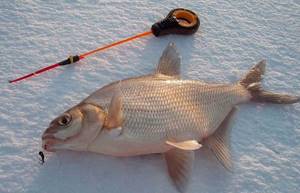
It is much more difficult to recognize a bite when jig fishing than in the same float fishing. The movements of the nod can be caused by the movements of the angler on the retrieve, the wind and many other factors. It is possible to correlate the nod signal with a bite only as you gain experience. It is especially difficult to recognize a bite in gear without a hook: there is no signaling device at all, and the bite is transmitted directly to the hand. It is clear that you won’t catch a bite in thick mittens, or with numb hands, so the problem of freezing your fingers is very, very relevant.
Often, the fish simply touches the jig without even thinking about attacking it, and the angler identifies the signal as a bite. What can we say: even seasoned winter roads have a certain percentage of idle cuts, so there is no need to make a tragedy out of this.
Winter fishing with a jig (especially with a reelless) requires an instant reaction: the fish, sensing something is wrong, immediately gets rid of the suspicious bait. Therefore, you need to cut immediately and quite sharply, exclusively with a brush. It is optimal that when hooking, the bait rises 30-40 cm (at idle speed, of course), so that you can immediately return it back before the trophy that is interested in it disappears. Fishing conditions can be different (depth, line stretch, bait weight), so these centimeters can only be measured experimentally.
If the hooking turned out to be effective, we proceed to fishing.
Ways to play with a jig
I would like to highlight this moment separately. After all, you can play with a jig in different ways to attract the attention of crucian carp.
The most common types of games are:
- The jig moves along the bottom with smooth and oscillating movements. Every few seconds it stops.
- The jig sinks completely to the bottom, then tap it on the ground, then lift it a little and move it to the other edge of the hole. Afterwards, this situation repeats itself again.
- The jig sinks completely to the bottom. As soon as she touches it, she immediately begins to rise, not too high - no more than 40 cm without sudden movements, everything is smooth. Then the jig lowers again, and everything repeats again.
- As soon as the jig touches the bottom, it begins to rise. But with twitching every few seconds.
- The jig gradually, smoothly, slowly, sinks to the bottom. Then he lies on it for 2-3 seconds, and then with light movements he rises 5 centimeters above the bottom.
Each method of play is catchy in its own way and works depending on a particular situation, so you should know about them all at once in order to be able to change the game of the jig if there is no bite.
Fishing
Fishing begins with raising the working hand with the tackle up (you can stand with your back to the wind, some anglers even move away from the hole). Next, you need to intercept the fishing line with your second hand (necessarily protected) and lift it as high as possible. The fishing rod needs to be thrown in the direction of the wind (if the trophy is small, then you can just carefully put it down).
The fishing line is alternately intercepted with your hands, keeping it taut. If the trophy is large enough, you need to pause, slightly release the tension, and then tighten the thread again, working exclusively with brushes with a small amplitude. At the same time, you need to make sure that the fish does not scour under the ice outside the hole: it will be much more difficult to remove it from there, especially if the hook of the jig gets caught on the back side of the ice.
It is advisable to do the last pull of the fishing line with your left hand, and remove the fish with your right hand, hooking it under the gills with your fingers. If the size of the prey is large (and even trophy bream and pike are caught with a jig), it is advisable to use a hook, otherwise the fishing line may not withstand the tension.
Mormyshing or nanojig. Effective modern fishing.
Mormodoch, mormyshing, nanojig - is this a joke? or a miracle invention of fishermen?
I would like to share my conclusions about studying the topic of mormodach or mormyshing. The first name caught on better among the people, but somehow it’s more pleasant to me – “mormyshing”. Let me say right away that I am very impressed with the mormyshing.
Part 1. Mormyshing is...
What is this you say? And why should I waste my time reading this article? I suppose since you are already here, then trust me and read. For some of you, this may be your favorite way to go fishing. Give this topic some of your precious time, and then take an ultralight spinning rod and run to master jig fishing (or similar fishing using the nanojig method).
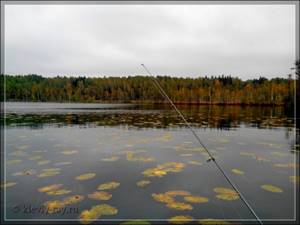
My ultralight spinning rod
Mormyshing and nanojig are almost the same thing, but with some differences. When jigging, we throw a light jig (with a piece of edible rubber) and play with it in the water column, and when nanojigging we use a very small one, up to 1 gram. jig head, hook and again edible rubber.
After watching individual videos on YouTube and studying fishing articles, I decided that I would definitely study this type of fishing. After all, he is catchy and non-standard. The second, you see, also makes you think. And not only predatory fish, but also white fish are caught this way. Judging by the reviews of anglers, large fish are found in the catches, including bream, rudd, crucian carp and even carp.
What can be said for sure? Mormyshing is not float fishing; it is not suitable for everyone. However, those who master it will almost always have a catch. In addition, jig fishing is a very sporty and delicate type of fishing and will not make you bored.
There are serious obstacles on the way to mastering mormyshing or nanojigging. Psychological obstacles arise here - is it possible to bite at this, is it even possible to throw a jig weighing 0.3 grams further than your nose, after all, the fish is not bad enough to rush to some kind of jig with a bare hook. And these statements have their place and indeed, for a beginner, as a rule, nothing immediately works out with mormyshing.
However, mormyshing (nanojig) is another invention of modern spinning anglers. And I dare say, an invention that allows you to get a lot of pleasure from fishing and, in most cases, catch other anglers.
My first experience did not bring a positive result, my fervor subsided, but recently I returned to this topic again and, as they say, I was “hooked” again. Now I’m planning to buy an ultra-light spinning rod for the purposes of mormo-wanking and nano-jigging. To begin with, I’ll take a reel from my Bolognese fishing rod and go to the reservoirs.
Part 2. Features of jig fishing gear.
A lot of time has passed since the first part of the article was written. However, during this time, I finally “spared” about 50 dollars and bought myself an ultralight spinning rod with a dough of up to 8 grams for my birthday.
Before that, I tried fishing with a light spinning rod with a weight of up to 12 g. Spinning rods are very different. A spinning rod with a weight of 12 grams is a very rough tackle for jig fishing. You can cast a jig, but the pleasure from retrieving is much less than that of an ultralight...
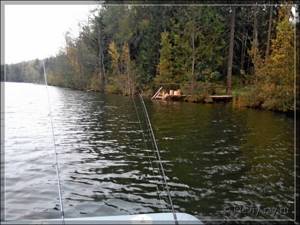
Mormyshing with ultralight
Looking ahead a little, I’ll say that in my opinion (up to 8 degrees) this is not the most convenient test for jig fishing. If the ultralight stick was up to 5 grams, then its sensitivity would be much higher and wiring the jig would be even easier. But such spinning rods cost at least twice as much, or even three, four, etc. once. In general, if you don’t mind spending money for a hobby, then it’s better to buy a more super-ultralight.
Let's continue... I attached a light reel from Bolognese tackle to my new ultralight spinning rod, equipped it with a 0.12 monofilament line and a small jig with a piece of edible rubber and went to relax and fish in the excellent Belarusian sanatorium Lesnoye in the Vitebsk region. And this was in September last year. Just when it’s already cold to swim, and the weather is just right for a predator.
Part 3. There is a result! Mormyshing works.
So, what do you think was the first fish I caught using jigs? That's right, you guessed it! It was a perch. Moreover, the perch only bit me. The classic spinning rod was useless these days. Perch and pike were on strike. But perch from 30 to 100 grams were regularly interested in this miracle tackle with a twitching jig.
Sometimes a roach was caught on the jig. When you pull a fish of about 100 grams on this delicate tackle, it seems that you have caught a whale - it’s cool.
In general, I will continue to study this unusual method of fishing. Our next task was to catch a large white fish using a jig. Do you think I will succeed? J
Try fishing with jigs or nanojigs. As soon as you catch your first fish, you will experience a lot of positive emotions. And this is what each of us strives for.
Good luck on fishing and in life!
Features of fishing for different types of fish
As mentioned above, there are no universal baits and wiring; the choice depends on many factors. But, for the most part, white fish like smooth movements with a large amplitude and decent pauses, while the predator prefers a more active and sharp game.
Let's go over the preferences of the main potential trophies:
- Bream . Bream is practically inactive in winter, so only experienced fishermen deliberately hunt for it. Usually medium jigs with bloodworms are used. In the dead of winter, it is most effective to fish “on the riser” (without playing) at night, with abundant feeding of dumps and edges near the wintering pits. In the hands of professionals, a medium-sized mothless reel will also work in the hands of professionals.
- Roach . The roach is a common trophy for winter anglers: this fish remains relatively active even in the bitter January frosts. Active search tactics work best, with the exception of very deep winter days. It is best to catch this fish using ultra-light fishing rods without reels and a jig with a nozzle made of bloodworms or maggots. For the first and last ice, you can experiment with a rewinder. Smooth play without sudden jerks is welcome.
- Crucian carp . Crucian carp, especially large ones, are not very active in winter. The golden one bites extremely rarely, but the silver one can be hunted. For this, the simplest and most inconspicuous jigs are usually used, without bright accessories, but the attachment must be extremely appetizing. Mothless fishermen rarely go after crucian carp purposefully.
- Perch . The voracious sailors are not particularly whimsical and are active at any time of the year; the humpback whale is much less common. Perch loves mud, so any fishing should include tapping on the bottom. In the wilderness, a monotonous game is used, at other times it is more chaotic. You can experiment with wiring as you like. When fishing with a reelless bait at great depths, bright colors and a very clearly marked attack point (like a bead in a “cat’s eye”) are welcome.
- Pike . To catch toothy torpedoes, super-heavy baits are used, which are jigs only in name. Rather, these are winter lures, the gear (winter spinning rods) and wiring used are similar. When using cone-shaped baits, an addition is necessary in the form of pieces or whole fish, bunches of worms (sometimes they use all sorts of exotic things like painted udders). We must not forget about the need for a leash: in the first ice, you can use a metal one, but in the dead of winter it is better to replace it with fluorocarbon.
- Sudak . The use of heavy jigs is especially effective in the dead of winter, when purely artificial baits such as winter spinners or wobblers do not attract fanged fish. Jig heads for silicone baits and “Uralkas” with sprat bait are often used as jigs. Fishing is usually carried out “on the riser”, downstream. Of the mothless species, the “devils” perform well. At great depths, fluorescent baits are good.
- Burbot . Freshwater cod treats the winter season very favorably: it is active, catches well with heavy jigs, and becomes especially active on the eve of spawning, which occurs in February. A fairly rigid fishing rod for winter trolling is suitable as the basis of the equipment. The jig used is extra heavy, several tens of grams, always with a refill of fry or sliced fish. As complementary food, water with fish remains (blood, giblets, scales, etc.) is poured into the hole. The main wiring is tapping the bottom. The main thing is to find the burbot’s parking place, which is problematic without an echo sounder.
What to catch?
Catching crucian carp depends not only on the right fishing rod. After all, if you prepare a super catchy fishing rod, but at the same time select the wrong bait and groundbait, then the possible success of catching crucian carp will tend to zero. Therefore, you need to prepare the appropriate bait and groundbait.
Lure (bait and bait)
If you are determined to catch a large specimen, then use baits and baits of animal origin. That is, such classic baits as bloodworms, maggots, and worms are perfect for you.
Crucian carp can sometimes be fussy eaters, so many fishermen use a combination of maggots and bloodworms. It is worth noting that the maggot is usually placed on the hook in the head area, as this is done for a natural look that can quickly attract crucian carp.
However, you shouldn’t think that only classic baits work, no. We recommend using it to catch various insects, larvae of the required size - leech, dragonfly larva, grasshopper. But at the same time, I would like to note that crucian carp also loves vegetable bait, for example, pearl barley.
So you can first try to catch fish using pearl barley, and if the fish don’t bite on it, then you can switch to animal bait.
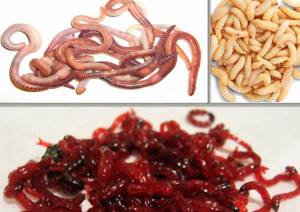
Animal bait – worms, maggots, bloodworms
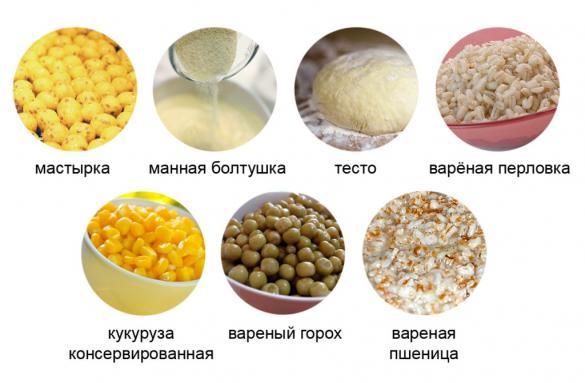
Vegetable baits
Lure
Winter crucian fishing cannot do without bait. But there is very little of it. The fact is that if you overdo it with bait, the fish will not take the bait and the catch will be meager. You can buy bait in the store - bait suitable for both crucian carp and carp fishing.
You can prepare your own bait, for this you will need:
- Breadcrumbs.
- Cake.
- Animal components. Often, fishermen use bloodworms as an animal component. But even here you need to know when to stop, because if there are a lot of bloodworms, it can saturate the fish and also attract perches to the fishing spot.
After this, the bait mixture is mixed with water and brought to the desired state. Then small balls are molded, the optimal dimensions are like walnuts or a little larger. 30 minutes before fishing, bait (2 balls) is thrown into each hole.
And then the most interesting part begins – the fishing itself. If you notice that the bite is starting to get worse, then you can add dry bait to the hole, but also stir it a little with a slotted spoon.

Bait for catching crucian carp
Variations of jigs
Many novice fishermen believe that crucian carp in winter do not pay attention to the action of the tackle so well, and the jig itself is more suitable for catching other types of fish. But it's not right. The fish does not particularly like the horizontal movement of the bait, but it responds well to vertical movement.
However, you also don’t need to think that any jig will do. No, crucian carp has a predilection for one size of nutrient diet, so a too large jig will not work, a small one is preferable.
The most common variations of jigs are:
- "Ball";
- "A drop";
- "Devil."
Tungsten jigs are preferred. The fact is that they sink to the bottom quite quickly, as a result of which they do not frighten or alarm the fish, namely crucian carp.
Also pay attention to the color of the jig.
The following are most suitable:
- black;
- yellow;
- red;
- orange;
- phosphorus jigs for fishing at night.
It is important to note that the behavior of crucian carp, like many other fish, is very cautious in winter. That is why, before you start fishing for crucian carp, be patient. The fact is that this fish, before swallowing the bait, savors it for a long time. Therefore, if you start fishing for it ahead of time, it will simply fall off.
Types of jigs
Angling tips
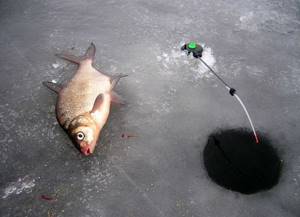
By tradition, at the end of the publication we give several recommendations to novice fishermen:
- Start simple. In this case, the simplest thing is stationary fishing with a riser, then switching to playing with a nozzle, and only after that the animation of the reelless fish.
- Don't chase the amount of gear. For the first time, two or three gear equipped for different conditions and a dozen spare baits are enough. Give preference to the classic options until you gain experience.
- Set up a fishing spot. This is especially true for fans of stationary fishing, who sit in a limited square with holes for hours. Periodically shovel snow, remove ice shards, take care of your own comfort and keep warm in every possible way.
- Store gear and equipment correctly. During and outside of fishing, store jigs in special containers with a foam cushion, sorting them by type, weight and diameter. When fishing, everything is stored in a fishing box; at home, it is thoroughly wiped and dried. Pay special attention to the care of the ice auger - this is the most expensive component of a winter fisherman’s equipment.
- While retrieving, keep an eye on the line. The thread should not touch the edges of the hole under any circumstances, so carefully monitor your own movements and at first choose simpler wiring. But don’t be afraid to experiment - if it doesn’t bite, then you need to change the style, bait, and maybe even the place.
- Don't forget about your own safety. During the first ice, a golden time begins for jig fishing lovers: fish can be caught well even by beginners; you don’t have to look for a place so carefully and pay attention to the fishing technique. Active search during this period is the best thing, but in the heat of excitement it is easy to forget about your own safety. Go out onto the ice only when its thickness reaches 5-7 cm, check its condition along the way, and hang a “rescue rescue” around your neck - a special device with which you can get out of the water on your own.
Mormyshing is a great hobby: accessible, useful and full of excitement. We guarantee: with each outing on the ice you will get more and more pleasure, and the scale of your catch will increase in proportion to the growth of your individual skill!
Fishermen wonder why I’m biting and they’re not?
I’m revealing a secret just for you: it’s all about the miracle bait! More details
How to fish at different times of the year
At different times of the year there are nuances that dictate the rules for proper fishing.
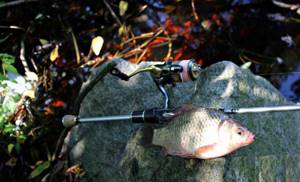
- Winter. At this time of year, spinning rods won't be needed because they don't catch fish.
- Spring. During this period, the fish begins to move away from winter hibernation. At the same moment, all river inhabitants go to spawn. After this process, the fish feed well from the very shore. Therefore, you need to be careful with wiring so as not to scare particularly cautious individuals. It must be said that the bait is cast along the shore.
- Summer. Summer jig fishing with a spinning rod bears fruit if you do everything correctly. Considering that the fish is clearly active at this moment, the wiring can be made more aggressive and bold. Casting should be done as far from the shore as possible.
- Autumn. With the arrival of this time of year, river inhabitants try to find some holes and hide in them. This often happens in October. Although it all depends on the region. In this case, you can easily fish with a spinning rod, but you need to select the right jigs. Elements should be light and small. If we talk about the game, it’s difficult to give any advice, because sometimes the fish grabs a bait that literally “flies” across the pond, and sometimes swims away from such a bait. In this case, you just need to try and look for your own option.
